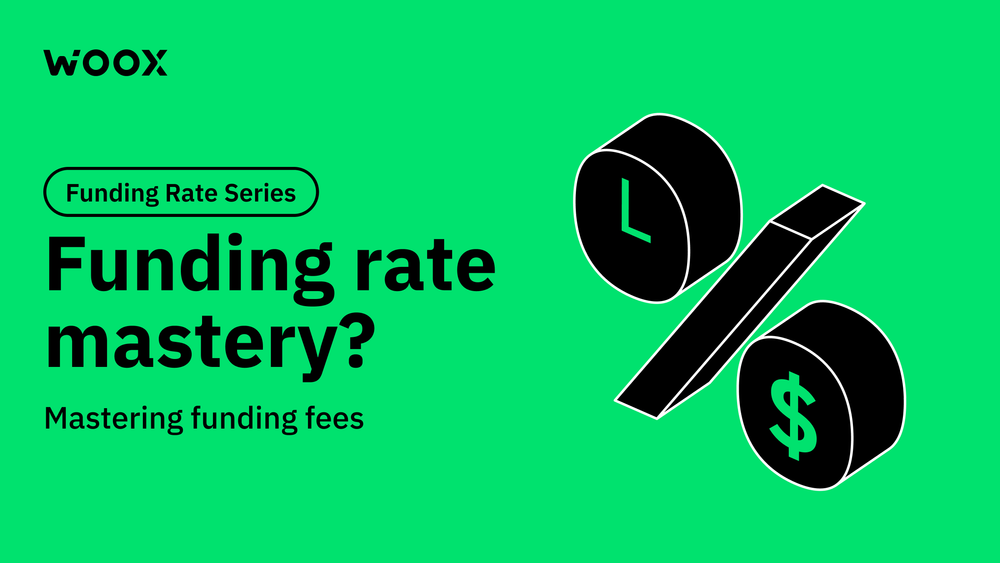How to calculate your funding fees and incorporate them into your trading plan
Funding fees are a crucial, yet frequently overlooked, aspect of trading crypto perpetual futures.
By understanding how funding fees are determined and factoring them into your trading strategy, you can more effectively manage risk, avoid unexpected costs, and improve your overall trading performance
This guide will break down the components of funding fees, including the funding rate, settlement intervals, and any additional charges that may apply. We’ll also demonstrate how to account for these fees in your trading plan, helping you make more informed decisions and optimize your returns.
What are funding fees?
Funding fees on WOO X are periodic payments exchanged directly between traders holding long and short positions in perpetual futures contracts. These fees primarily consist of the funding rate, which is calculated to keep the perpetual contract price aligned with the underlying spot market price.
Purpose:
Funding fees incentivize traders to maintain market balance by encouraging positions that keep the perpetual contract price close to the spot price, preventing significant price deviations.
How they work:
On WOO X, funding payments are settled every 8 hours by default—at 12 AM, 8 AM, and 4 PM UTC—though the platform reserves the right to adjust intervals during extreme market conditions.
When the funding rate is positive, traders holding long positions pay those holding shorts; when negative, shorts pay longs.
Funding fees are settled in USDT and are calculated as:
Funding fee=Funding rate×Position notional=Funding rate×Holding×Mark price
Additional information:
For cross margin positions, funding fees are deducted directly from your cross collateral.
- For isolated margin positions, WOO X first attempts to collect fees from your cross margin USDT balance.
- If insufficient, it cancels pending orders that would open new isolated positions for that symbol, and if still inadequate, deducts fees from the isolated margin itself.
- This layered approach ensures funding fees are reliably settled without unexpected liquidation risks.
Understanding these components of funding fees on WOO X is essential for effective risk management and accurate cost calculation in perpetual futures trading.
Step-by-step guide to calculate your funding fees
Understanding your funding costs is essential to protecting your profits and managing risk in perpetual futures trading. Here’s how to break down the calculation using the current BTC price:
1. Calculate your position notional value
First, determine the notional value of your position by multiplying your contract size by the current mark price.
Formula:
Position Notional Value = Position Size × Mark Price
Example:
If you’re holding a 2 BTC long position and BTC is trading at $100,000:
2 × $100,000 = $200,000
2. Find the current funding rate
Check the current funding rate for your contract. On WOO X, you can view this directly on the trading page or on the funding rate dashboard. Funding rates are typically quoted as a percentage and are most of the time updated every 8 hours on WOO X but this may evolve depending on market conditions.
Example:
Funding rate = 0.03% (every 8 hours)
3. Calculate the funding fee
Multiply your notional value by the funding rate to get your funding fee for the interval.
Formula:
Funding Fee = Position Notional Value × Funding Rate
Example:
$200,000 × 0.03% = $60 per funding interval
4. Determine payment direction
- Positive funding rate: Longs pay shorts.
- Negative funding rate: Shorts pay longs.
If the rate is positive and you’re long, you’ll pay the fee. If you’re short, you’ll receive it.
5. Factor in the funding interval
Funding is charged every 8 hours. To estimate your daily or longer-term costs, multiply your per-interval fee by the number of intervals.
Example:
$60 × 3 (for 24 hours) = $180 per day
6. Incorporate Funding Costs into your trading plan
- Short-term trades: Funding fees may be minor, but always check rates before entering a position—especially during volatile periods.
- Long-term holds: Funding costs can add up quickly. Factor them into your break-even and profit targets to avoid surprises.
7. Monitor Funding Rate changes
Funding rates are dynamic and can shift rapidly with market sentiment. Set alerts or check rates regularly, especially if you’re holding positions through periods of high volatility.
Pro tip:
Funding rates aren’t just a cost—they’re a sentiment signal. Persistently high positive rates can flag an overcrowded long trade and potential for a sharp reversal, while negative rates may indicate bearish extremes and possible short squeezes.
By following these steps, you can accurately track your funding costs and make smarter, more informed decisions in your perpetual futures trading.
Funding fees examples based on market and position
Incorporating funding fees into your trading plan
Funding fees aren’t just a line item—they’re a dynamic cost that can quietly eat into your profits or, if managed well, become a strategic advantage.
Here’s how to keep them front and center in your trading plan, in line with a practical, data-driven approach:
Budget for Funding Fees
- Treat funding fees as a core trading expense, alongside spreads, commissions, and slippage.
- Before entering any position, estimate your potential funding costs over your intended holding period.
- This helps you set realistic profit targets and avoid unwelcome surprises.
Adjust position size and holding time
- Larger positions and longer holding periods amplify funding costs. If you’re planning a swing trade or holding leverage overnight, factor in cumulative funding fees.
- Consider scaling down your size or shortening your holding time if rates are elevated, especially during periods of high market demand.
Monitor Funding Rate trends
- Funding rates are a real-time sentiment gauge.
- Persistently high or volatile rates often signal overcrowded trades or an impending shift in market direction.
- Use these trends to time your entries and exits, entering when funding rates normalize can help you avoid paying a premium to be on the “crowded” side of the market.
Hedge or offset funding fees
- Explore strategies to offset or hedge funding costs.
- For example, opening offsetting positions on different exchanges, or using spot and derivatives together, can help neutralize funding outflows.
- Some traders even seek to earn funding income by positioning themselves on the side that receives payments during periods of extreme market sentiment.
Risk management
- Unexpected spikes in funding rates can quickly erode profits or deepen losses.
- Include funding cost scenarios in your risk calculations and regularly stress-test your positions.
- This ensures you’re not caught off guard by sudden changes, especially during volatile market conditions.
By proactively budgeting for funding fees, adjusting your trade parameters, and using funding trends as a market signal, you can turn a hidden cost into a powerful component of your overall trading strategy.
Key takeaways
Funding rates fluctuate based on market demand and supply, so your funding fee will vary with changing market conditions over time.
- You can assess in the funding rate history of the trading pairs here.
- Always calculate funding fees before entering a position, especially if you plan to hold for the long term—these costs can accumulate and impact your bottom line.
- Incorporate funding fees into your overall trading plan alongside other expenses like spreads and commissions to avoid surprises and optimize profitability.
- Use funding rate trends as a real-time market sentiment indicator—extreme values can signal crowded trades or potential shifts, offering valuable insight for strategic decision-making.
- You can check the current funding rates across the various trading pairs here.
Understanding and calculating your funding fees is essential for any trader serious about crypto derivatives. By integrating these costs into your trading plan, you can improve risk management, avoid unexpected expenses, and enhance your overall trading performance.
Disclaimer
The information provided in this article is for general informational purposes only and does not constitute financial, investment, legal, or professional advice of any kind. While we have made every effort to ensure that the information contained herein is accurate and up-to-date, we make no guarantees as to its completeness or accuracy. The content is based on information available at the time of writing and may be subject to change. We make no representations or warranties, express or implied, about the completeness, accuracy, reliability, suitability, or availability with respect to the information, products, services, or related graphics contained in this article for any purpose.
Cryptocurrencies and related products involve significant risk and may not be suitable for all investors. The value of digital currencies and related products can be extremely volatile, and you should carefully consider your investment objectives, level of experience, and risk appetite before participating in any investment activities.
We strongly recommend that you seek independent advice from a qualified professional before making any investment or financial decisions. We shall in NO case be liable for any loss or damage arising directly or indirectly from the use of or reliance on the information contained in this article.


